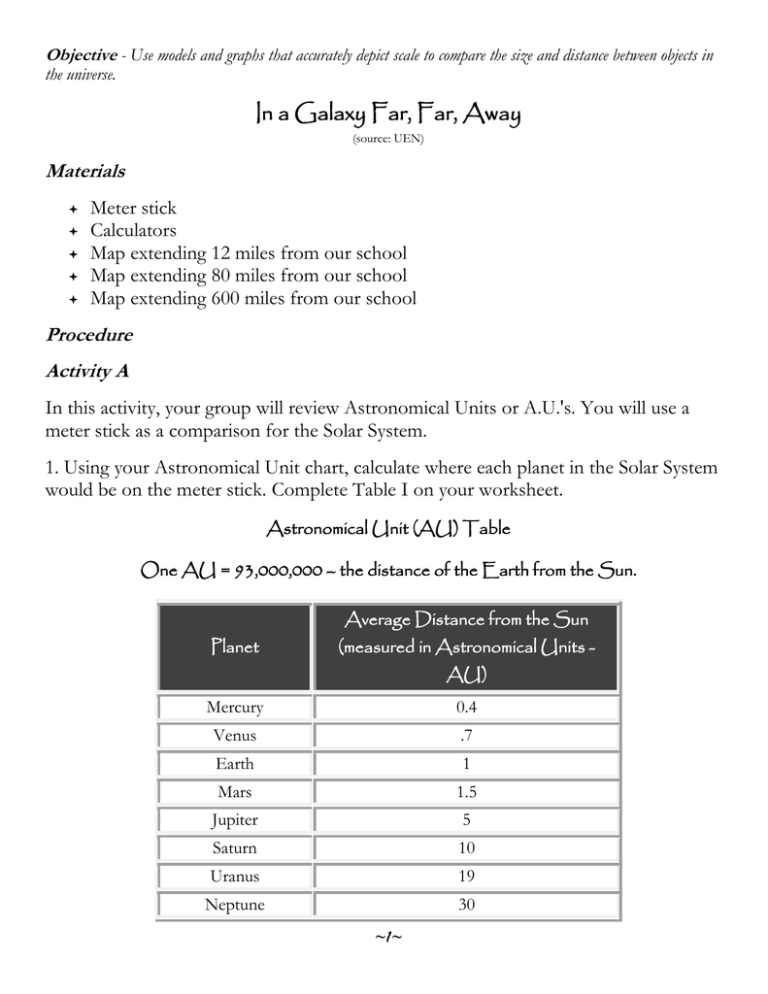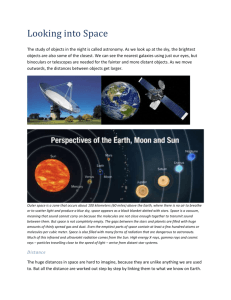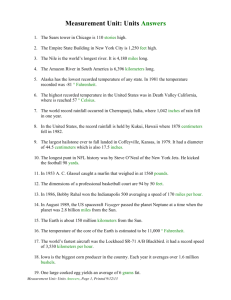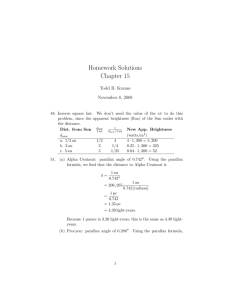In a Galaxy Far Away
advertisement

Objective - Use models and graphs that accurately depict scale to compare the size and distance between objects in the universe. In a Galaxy Far, Far, Away (source: UEN) Materials Meter stick Calculators Map extending 12 miles from our school Map extending 80 miles from our school Map extending 600 miles from our school Procedure Activity A In this activity, your group will review Astronomical Units or A.U.'s. You will use a meter stick as a comparison for the Solar System. 1. Using your Astronomical Unit chart, calculate where each planet in the Solar System would be on the meter stick. Complete Table I on your worksheet. Astronomical Unit (AU) Table One AU = 93,000,000 – the distance of the Earth from the Sun. Average Distance from the Sun Planet (measured in Astronomical Units AU) Mercury 0.4 Venus .7 Earth 1 Mars 1.5 Jupiter 5 Saturn 10 Uranus 19 Neptune 30 ~1~ Objective - Use models and graphs that accurately depict scale to compare the size and distance between objects in the universe. 2. Distances in space are so huge, another measuring unit, light-years, is needed to measure. 3. A light-year is the distance that light travels in one year. Look at the Speed of Light handout. 3. Use your Planetary Data Sheet. Calculate how long it takes light from the Sun to reach each planet. Use the following formula(s): Distance to planet (miles) 186,000 mps (miles per second) = time it takes for Sun’s light to reach planet. o 87,000,000 186,000 = 467.7 seconds (round to one decimal point). To get minutes, divide seconds by 60 (467.7 ÷ 60 = 7.8 minutes – round to one decimal point). o 785,000,000 186,000 = 4,220.4 seconds = 70.3 minutes. = 1.2 hours To get hours, divide minutes by 60 (70.3 ÷ 60 = 1.2 hours – round to one decimal point). Planetary Data Sheet Planet Distance from Sun (miles) Mercury 36,000,000 Venus 67,000,000 Earth 93,000,000 Mars 141,000,000 Jupiter 484,000,000 Saturn 887,000,000 Uranus 1,780,000,000 Neptune 2,870,000,000 4. Using the scale: 1” = 2 light-years, twenty-one stars are within twelve light-years of our Solar System. Seven of them are visible with the unaided eye. Only two of these are among the brightest stars (Sirius and Procyon). The other stars are red dwarfs and only visible with a telescope. Of the thirteen brightest stars visible in the Northern ~2~ Objective - Use models and graphs that accurately depict scale to compare the size and distance between objects in the universe. Hemisphere, ten of them are within seventy-seven light-years. The other three stars are from 197 to 522 light-years away. 7. Get your map that extends about 12 miles from your school. Locate Alpha Centauri, Sirius, and Procyon. (Use the scale 1” = 2 light-years.) Mark the locations on the map with a different color pencil and identify the star. 8. Get your map that extends about 80 miles from our school. Locate all stars between and 77 miles on the map. (Use the scale 1” = 15 light-years.) 9. Get your map that extends about 600 miles from our school. Locate all stars greater than 80 miles on the map. (Use the scale 1” = 100 light-years.) The Distance to the Thirteen Brightest Stars Star/Constellation Actual Distance Scale Distance 1 light-year =1 mile Alpha Centauri* Centaurus (Southern Hemisphere) 4.5 light-years 4.5 miles Sirius - Canis Major 8.6 light-years 8.6 miles Procyon - Canis Minor 11 light-years 11 miles Altair - Aquila 17 light-years 17 miles Vega – Boötes 25 light-years 25 miles Fomalhaut – Piscis Austrinus 25 light-years 25 miles Pollux – Gemini 34 light-years 34 miles Arcturus – Boötes 37 light-years 37 miles Capella – Auriga 42 light-years 42 miles Aldebaran – Taurus 65 light-years 65 miles Regulus – Leo 77 light-years 77 miles ~3~ Objective - Use models and graphs that accurately depict scale to compare the size and distance between objects in the universe. The Distance to the Thirteen Brightest Stars Star/Constellation Actual Distance Scale Distance 1 light-year =1 mile Antares – Scorpius 197 light-years 197 miles Spica – Virgo 262 light-years 262 miles Betelgeuse – Orion 522 light-years 522 miles *Alpha Centauri is not one of the thirteen brightest stars. It is included for comparison since it is the next nearest star to our Solar System ~4~ Objective - Use models and graphs that accurately depict scale to compare the size and distance between objects in the universe. Names _____________________________________________________________ ___________________________________________________________________ Absent _____________________________________________________________ In a Galaxy Far, Far, Away Table I - Distance to Planets – Scale = Inches Relative Distance of Planets: Scale =1 A.U.=1 inch Mercury Venus Earth Mars Jupiter Saturn Uranus Neptune Table II - Distance to Planets – Scale = Light-years Light Time Travel from the Sun Mercury Venus Earth Mars Jupiter Saturn Uranus Neptune ~5~ Objective - Use models and graphs that accurately depict scale to compare the size and distance between objects in the universe. Teacher’s Notes Instructional Procedures Invitation to Learn Show a clip from the movie Star Wars where Han Solo jumps his spaceship The Millennium Falcon, to light speed (about one hour into the film). Discuss: Is this possible? How long would it take even if it were possible? And/or Discuss with students how things might be measured using different scales. Show students that using some units of measure are not practical. http://www.cleanvideosearch.com/media/action/yt/watch?videoId=jsNv6c6chBA Would you measure how long the playground is using millimeters? Would you measure how long a book is by how many letters are in it? Would you measure how many chocolate chips in a cookie recipe by counting each chocolate chip? Would you say how old you are by using minutes? Introduce the idea that distance in the universe is measured in light-years. Explain that distances in space are enormous and that light-years are a more practical scale than using kilometers or miles. One nice way to get a local map is to use the Internet site http://maps.yahoo.com to create a map with your school at the center. The website offers a variety of zoom magnifications. You can put your school at the center of the map by adjusting the North, South, East, and West directional arrows. Answer Activity A – Table I Relative Distance of Planets: Scale =1 A.U.=1 inch Mercury Venus Earth Mars Jupiter Saturn Uranus Neptune Pluto 3/8 inches 3/4 1 1 1/2 5 1/4 9 5/8 19 1/4 30 1/8 inches inches inches inches inches inches inches ~6~ 39 1/2 inches Objective - Use models and graphs that accurately depict scale to compare the size and distance between objects in the universe. Answer Activity B – Table II Light Time Travel from the Sun Mercury Venus Earth Mars Jupiter Saturn Uranus Neptune Pluto 3 m 13 s 6m1 8m s 19 s 12 m 43 m 40 s 16 s 1 h 19 2 h 39 4 h 10 m 5 h 28 m m 28 s m 50 s 25 s 53 s ~7~ Objective - Use models and graphs that accurately depict scale to compare the size and distance between objects in the universe. The Universe in Numbers The Milky Way is 100,000 light-years across and 2,000 light thick at its center. Our Sun is 30,000 light-years from the center of the Milky Way. There are more than 100,000,000,000 (one hundred billion) galaxies in the universe. Each galaxy has between 100,000,000,000 and 300,000,000,000 (three hundred billion) The Andromeda Galaxy is the nearest galaxy to ours. It is 2,900,000 light-years away and 150,000 light-years across. The Local Group contains 50 galaxies and is 5,000,000 light-years across. ~8~ Objective - Use models and graphs that accurately depict scale to compare the size and distance between objects in the universe. The Speed of Light 186,000 miles per second 300,000 kilometers per second 11,160,000 miles per minute 18,000,000 kilometers per minute 69,600,000 miles per hour 1,080,000,000 kilometers per hour 16,070,400,000 miles per day 25,920,000,000 kilometers per day 112,492,800,000 miles per week 181,440,000,000 kilometers per week 5,865,696,000,000 miles per year 9,460,800,000,000 kilometers per year ~9~






